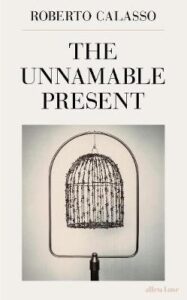The Unnamable Present by Roberto Calasso, 2019, Allen Lane, London, 2019

This is a challenging book to review – there is this evocative takeaway that keeps resonating with you but is difficult to explain. The fact that writing is not straightforward further complicates the matters. It is not so much that sentence constructs and choice of words are complex. It is more the fact that the author keeps switching endlessly between his thoughts and episodes and philosophers of new and old. The author discusses precepts from the Vedas and thinking of ISIS within a spate of few pages. Nevertheless, he still manages to tie subjects together.
The heart of the book, the first chapter, is the author’s attempt to picture the ills afflicting the contemporary world – to be more precise, a secular – digital world. This world looks down upon the concept of religion in its traditional form. However, in the end, it comes to consider itself the final evolution of human society. It defines itself as the ultimate object of reverence. It ends up becoming a religion in itself, with relentless advertising and spontaneous self-exhibition as its forms of mantras and hymns.
As the author points out, secularism may be the fundamental cause of the ills of modern society, the most important being a constant presence of fear and anxiety as if things are always hanging by a thread. Secularism has eliminated the concept of obligations – the ones like the four debts propounded by Vedic seers. All one needs to do is pay taxes on time and be on the right side of the law. Despite this immense liberating freedom, the secular man is not happy. He continues to feel a great deal of psychological burden.
But to qualify, he also points out that for secularism to be triumphant requires a particular type of wisdom where people stop believing, but limit themselves to observing, studying, and understanding. Clearly, the rich literature on self-improvement and positive thinking books, filled with just a different form of spirituality and percepts, show this is far from the fact. The act of constant observation requires a lucid and concentrated mind which the technology makes sure remains challenging to achieve.
According to the author. Secularism suffers from two fatal flaws. First, its foundational twin pillars of free will and belief in science are at odds. Science shows no sign of belief in the existence of a free will. Instead, it looks to reject it through continuous arguments and experiments. But public life goes on as though this was not the case. Otherwise, the whole administrative, political and judicial setup will come to a halt.
Secondly, secularism is eventually linked to democracy. But what can one do when someone reaches power by legitimate means intending to abolish democracy itself – which is a growing trend in all contemporary democracies and brought the world near-collapse some 80 years ago? To address this, there have been rising calls for direct democracy. In the larger frame, direct democracy is a part of expanding demands for disintermediation (especially using technological means). But is disintermediation always beneficial? Do we expect every farmer to be well versed in the ways of economics and every economist well versed in agriculture? There is a belief that technology has made the need for specialists and intermediation redundant by making information available widely.
This argument is highly flawed cause in the new era, power is knowing what to ignore. Knowledge has become every growing juxtapose of impeccably reliant and baseless information, which eventually encircles thought and suffocates contemplation.
The second chapter is history running live to show what happens when democracy decides to kill itself. It is a set of writings – letters, stories, notes, etc. from intellectuals during the Europe of 1930s, with no interpretation from the author. The tempo builds up gradually as the horrors of the war come forth. The tempo peaks with a corporate notification which is spine chilling – on why the gas supply was being stopped to a certain section of the society, as they were using it to commit suicide and hence have been unable to pay up their dues.
This finally brings me to the cover image of the book – first, I could not understand the message that is being conveyed. However, as I started going through the book, the meaning became clearer – a bird in a cage can generally relax as there is not much to fly around, and necessities will be taken care of. But what happens when the cage is like a barbed fence – for the bird now can find no rest, it needs to keep flying all the time, but this flying is in some sense meaningless as there is no new destination to explore and no new truth to find.



